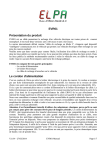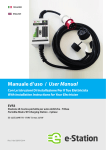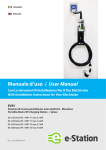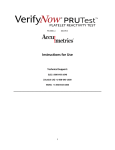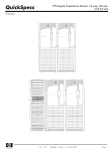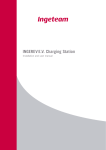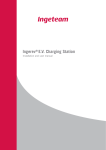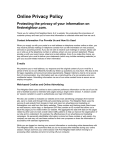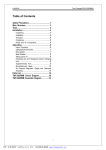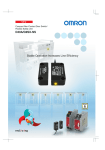Download EVR01 General description Input power cord
Transcript
S.a.s. di Rizzo Davide & C. EVR01 General description EVR01 is a device that allows you to recharge an Electrical Vehicle from any standard mono-phase source of power. The international standard defines “Mode 2 recharging cable” any device that allows an Electrical Vehicle to be recharged from a standard power outlet. Please note that in some countries like Italy, the use of mode 2 recharge cable in public places is forbidden by law, they can only be used in private places. In public places the recommended way is to connect the car with a mode 3 charging cable (that has no electronic) to a public recharge station. EVR01 is composed of 3 main parts: – The input power cord – The electronic box – The car recharge cable Input power cord It's a short 30cm cord that connects the electronic box with the power socket. This cord is terminated with an industrial mono-phase power plug. Depending on the maximum current capability you can have a connector that can manage up to 16A or up to 32A. The input power cord carries only power wires, there is no communication between the electronic box and the power source, so the electronic box cannot know the maximum current it can get from the socket. Because the power source is unknown, the user must select the maximum allowed current without exceeding the maximum current allowed by the power source. An interlocked socket is a socket mechanically connected with an electrical switch, you cannot turn the switch on without a plug inserted and you cannot remove the plug if the switch is in the on position. It has 2 important advantages: – You are sure that no power is applied if there is no plug inserted – You cannot remove the plug while power is applied We suggest to install a compatible industrial grade interlocked socket in every location you wish to recharge your car. The normative forbids to use standard adapters because they are not designed to manage high currents for long times, it must be plugged directly in any compatible socket. Anyway for practical uses we provide some specific current limited adapters that can manage high V.1.04 – 27/03/2014 EVR01 Manual Page 1/7 S.a.s. di Rizzo Davide & C. currents for long times. The Schuko adapter has an over-current limiter at 10A, if the user selects a bigger current the protection after some time will trip and disconnects the power. If this happens, it must be manually restored by pushing it. Please beware that domestic Schuko sockets also if rated 16A are not designed for continuous use at high current, also 10A can be dangerous and must be avoided. Continuous use at high current can deteriorate the socket causing future damages. ELPA suggests to select only 6A or 8A when using Schuko sockets, it's your responsibility to check the power source for overheating. We suggest to use only industrial 16A or 32A interlocked sockets, that are guaranteed to manage their maximum rated current forever without overheating problems. Any power socket used for recharging must be protected with a suitable shape C over-current breaker and a 30mA type A residual current breaker, their installation should be certified by your electrician. For mono-phase these 2 protections are cheap and easy to find integrated in a single device. Electronic box It's the heart of the system, it interfaces the car with the power socket. It communicates with the car using the J1772 widely adopted communication protocol standard for the recharge of Electrical Vehicles. It has 2 pushbuttons to select the maximum current the car can get, and one pushbutton to enable / disable the recharge. It has also an internal residual current sensor that switches recharge off if the residual current exceeds 42mA. This is for safety, residual current should be 0. During switch on and switch off a self test is performed to test the internal switches. An internal sensor switches off the power if the temperature inside the box reaches 70°C. Car recharge cable It's 7.5m long to reach your car in any position, it carries power to the car and communication between the car and the electronic box. That's a custom cable manufactured for ELPA, oil and flame repellent. It's terminated with a special female connector that must be plugged into the car. This is available in 2 versions: – Type 1: It's called Yazaky, it's used mainly in Japan and USA; all cars sold in Europe before 2013 have this connector. It has 3 power and 2 signal contacts. It can carry only mono-phase power. It has a pushbutton on the top, that must be pressed to remove the plug from the car. It can be locked on the car by inserting a mechanical locker(not provided) in a hole that V.1.04 – 27/03/2014 EVR01 Manual Page 2/7 S.a.s. di Rizzo Davide & C. locks the pushbutton lever. – Type 2: It's called Mennekes, it's the connector that will be used on all European cars. It has 5 power and 2 signal contacts, because it can carry mono-phase or 3-phase power. Anyway, EVR01 manages only mono-phase recharge. It's automatically locked on the car during recharge by an electromechanical locker inside the car. Operating instructions You can change the current level using the + and – keys. The correct sequence to start a recharge is: – Plug in the cable to the power socket, if it has a switch turn it on. – Select the desired current level (8A minimum for Renault Zoe) – Plug in the car connector into the car If you connected to a Schuko socket you should select only 6A or 8A. 10A should be used only on strong sockets like “GreenUp”, otherwise the socket could overheat. If you connected to a CEE 16A socket you can select any level up to 16A. Only if you connect to a CEE 32A socket you can select any current level: 6A, 8A, 10A, 13A, 16A, 20A, 24A, 28A, 32A. Note: EVR01-16A cables don't allow you to select current levels >16A. To switch from 10A to 13A and from 16A to 20A you must keep pressed the + key for 1 second. Please note that this signals to the car's charger the maximum allowed current, the car can use any value lower than the maximum allowed. Normally the real current is about 0.5A less than the maximum allowed but this is not always true, especially at the end of the recharge cycle it can be much lower. If you select a maximum current bigger than the maximum current that the car's charger can manage, it will use all the current it can manage (most electric cars now have 16A limited charger). Do not select a current level greater than the power plug maximum limit: 8A for domestic Schuko, 16A for CEE small size, 32A for CEE medium size, otherwise you can damage both the plug and the socket. The plug adapters have a thermal over-current switch that will trip if the maximum allowed current is exceeded for some time. This is to protect both the plug and the socket, that could overheat. When they trip they disconnect the power and the recharge will interrupt, to reset you must press them. The car's state selects the operating mode following this table: Bottom led V.1.04 – 27/03/2014 Status Car recognized EVR01 Manual Power applied to car Page 3/7 S.a.s. di Rizzo Davide & C. Off Off No No Slow blink Pause Yes No Fixed Recharge Yes Yes Fast blink Recharge vent required Yes Yes If the led is fast blinking the car is signaling that the room temperature is too high, so you should vent the room. EVR01 continues to charge in this state. If some problem arises, EVR01 interrupts charge and blinks one current led: 20A blinking: Relay stuck open: EVR01 needs assistance 24A blinking: Relay stuck closed: EVR01 needs assistance 28A blinking: 42mA residual current limit exceeded 32A blinking: 70°C over-temperature error Some cars lock the plug while recharging. Please refer to the car's user manual to release it. IMPORTANT: Never disconnect plugs while recharging, when the bottom led is on or blinking. Disconnecting the plug while high current is flowing can damage both the plug and the socket. First you must stop the recharge and then you can disconnect the power plug. Compatibility list At the manual release date, EVR01 was succesfully tested on: Peugeot Ion Nissan Leaf (all versions) Smart ED Renault Kangoo (all versions) Renault Fluence Renault Zoe Opel Ampera Tesla Model S BMW I3 Long life note The battery life is very dependent from the charging current: the lower the current, the longer its life. We suggest to use always the minimum current compatible with the recharge time you have. V.1.04 – 27/03/2014 EVR01 Manual Page 4/7 S.a.s. di Rizzo Davide & C. The 32A setting should be used only when you are in a big hurry. Renault Zoe specific The Renault Zoe charger's main feature is to allow the recharge at high power, up to 43.5kW with 3phase, allowing 80% battery recharge in only 30 minutes. Because it can manage such a big power, it has additional safety features that impose some additional constraints also in low power recharging. About half of people using EVR01 to recharge Zoe experienced some problems at the beginning. These are mainly caused by the charger's restrictions. The more frequent problems are: – Residual current protection activation: Zoe escapes about 30mA toward ground, they are enough to trigger many 30mA type AC RCD external protections. This problem can only be solved substituting the RCD with a 30mA type A that is stronger. This is also required by the current normative about recharging of electrical vehicles. – Charge refuse: The more common situation that happens at startup: the bottom led starts to blink for some seconds, then you hear 4 click and the led becomes fixed on. After some seconds, you hear 1 click, EVR01 go into the “Pause” state, led blinks again, and on the dashboard you read “Verifying” or “Recharge not possible”. This situation can be caused by: 1) Phase/neutral inversion: Zoe requires correct positioning of phase and neutral: this is a problem mainly with domestic Schuko adapter. In some countries you can invert phase with neutral by turning the Schuko plug by 180°, but in France you cannot because the socket is polarized: with the earth on the top, neutral must be on the left and phase on the right. If the socket is wired in the wrong way, you cannot use that socket to recharge a Zoe. In the industrial sockets, with earth toward the bottom phase must be on the left and neutral on the right. Normally the message “Recharge not possible” identifies this problem. 2) Earth resistance must be less than 100Ω 3) Minimal allowed current in mono-phase is 8A. 6A may be accepted at start, but it aborts after some minutes. Renault suggests minimal current of 13A. 4) Voltage between neutral and earth must be very low. If you have only 2-phase power like in USA or Rome (Italy) you must insert an insulation transformer. 5) The conductor's cross section must be adequate, at least 2.5mm² up to 16A and 6mm² up to 32A, if the line is longer than 10m you must use bigger sections. 6) Also some loose connection may cause the charger to not start. 7) If Zoe is fully charged, it signals to EVR01 that disconnects the power lines. If you aren't able to recharge Zoe we suggest to try using a different socket, in 99% of cases these problems were caused by the power socket and were not related to EVR01. Please note that the Zoe's charger is optimized for high power but has bad performances at low V.1.04 – 27/03/2014 EVR01 Manual Page 5/7 S.a.s. di Rizzo Davide & C. power, at 8A efficiency is about 50% and cos(Φ) is 0,7. < 16A current should be used only in emergency situations. At 32A the charger efficiency is about 80%. Warranty EVR01 and accessories have a standard warranty of 1 year. Warranty doesn't include the shipping to ELPA. Ordering codes EVR01-32A-T1: Recharge cable 32A max with industrial 32A plug and Type 1 car connector EVR01-32A-T2: Recharge cable 32A max with industrial 32A plug and Type 2 car connector EVR01-16A-T1: Recharge cable 16A max with industrial 16A plug and Type 1 car connector EVR01-16A-T2: Recharge cable 16A max with industrial 16A plug and Type 2 car connector Optional accessories for EVR01-32A: – ADAP3232T: adapter with 32A 3-phase industrial plug – ADAP3216T: 16A current limited adapter with 16A 3-phase industrial plug – ADAP3216: 16A current limited adapter with 16A monophase industrial plug – ADAP3210: 10A current limited adapter with Schuko plug – SOCK32: 32A interlocked monophase industrial socket Optional accessories for EVR01-16A: – ADAP1616T: adapter with 16A 3-phase industrial plug – ADAP1610: 10A current limited adapter with Schuko plug – ADAP1632: adapter with 32A monophase industrial plug – ADAP1632T: adapter with 32A 3-phase industrial plug – SOCK16: 16A interlocked monophase industrial socket All devices and accessories have IP44 protection level when connected, so they can be used outside and exposed to rain. Certifications EVR01 was tested against all related CE normatives: EN61851-1:2011, EN61000-6-2:2005 + /EC:2005 + /IS1:2005, EN61000-6-3:2007 + /A1:2011. EVR01 complies to almost all of Renault ZE-Ready specifications and it was tested with all the Renault electric cars, but for commercial reasons actually it's not ZE-Ready certified. V.1.04 – 27/03/2014 EVR01 Manual Page 6/7 S.a.s. di Rizzo Davide & C. Disclaimer ELPA is not responsible for any damage caused by improper use of the cable. Mode 2 recharge cables like EVR01 cannot know the power socket connected, and the maximum current available depends on the socket. It's the user responsibility to choose an appropriate current level, without exceeding the power socket's current limit. Contacts For every question or suggestion please contact us: ELPA s.a.s. Di Rizzo Davide & C. via Rocciamelone 3 10040 Caprie (TO) ITALY tel.: +39.011.9636656 e-mail: [email protected] Updates History 06/05/13 Hardware + firmware update: raised residual current limit from 22mA to 35mA 08/06/13 Released manual V.1.01 17/06/13 Firmware update: added status restore at power-up 02/07/13 Released manual V.1.02 10/07/13 Updated Zoe specific chapter (version 1.03) 16/09/13 Solved Leaf 2013 hardware compatibility issue 10/10/13 Added firmware autostart feature 16/01/14 Solved Leaf 2013 timer mode firmware issue 27/03/14 Released manual V.1.04 V.1.04 – 27/03/2014 EVR01 Manual Page 7/7







